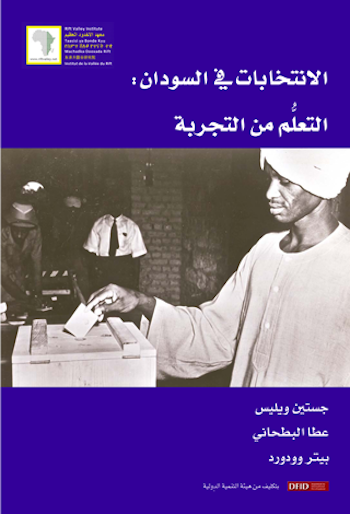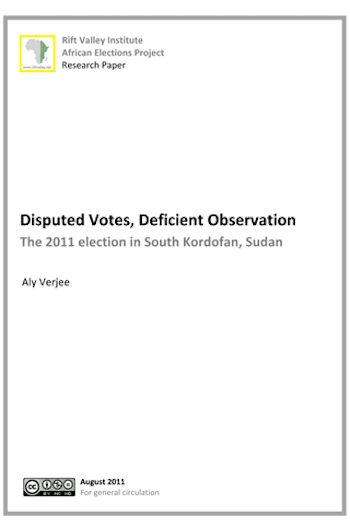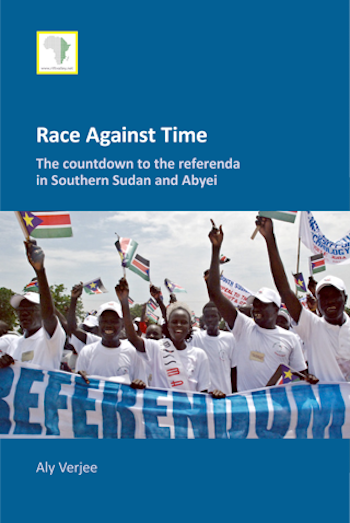Abyei has proved to be the hardest part of Sudan’s Comprehensive Peace Agreement (CPA) to implement, harder, even, than the determination of the rest of the North-South boundary, or the division of oil revenues. In this personal commentary Douglas…
RVI publishes books, research reports, research papers, briefings and meeting reports in a range of formats. Publications cover policy, research, arts, culture and local knowledge in the countries of eastern and central Africa. Research publications—books, reports and papers—are peer-reviewed. Some RVI publications are also available in French and/or Arabic.
The RVI is a signatory of the Budapest Open Access Initiative (2001); all publications are free for download in PDF format under Creative Commons licences. The views expressed in books and reports published by the RVI are those of the authors, not the Institute.
SEARCH
PUBLICATION TYPE
LANGUAGE
REGION
COUNTRY
RVI Fellow Douglas Johnson discussed the implications of South Sudan’s independence for the new nation’s history, historiography, and sense of identity in his keynote lecture to the 9th International South Sudan and Sudan Studies Conference in Bonn in July…
The war in South Kordofan, Sudan, that began in May 2011 followed a disputed election for the governorship of the state, an election endorsed by international and national election observers. This study argues that that there were significant deficiencies…
This report examines Sudan’s history of elections, and asks why they have failed to produce the kind of stable yet dynamic government in Sudan that the secret ballot is intended to encourage. Elections in Sudan analyses the varied forms of malpractice…
Published on the eve of voter registration for the referendum in South Sudan, Race Against Time analyses the unresolved procedural problems, technical difficulties, and disputes threatening the self-determination process. The report includes timelines, a guide to electoral bodies, comparisons…

- By Aly Verjee
- Download
إن تقرير سباق مع الزمن الذي ينشر أثناء فترة تسجيل الناخبين لإستفتاء جنوب السودان يحلّل المشاكل الاجرائيّة المستعصية والصعوبات الفنيّة والنزاعات التي تهدد عمليّة تقرير المصير في جنوب السودان وابيي. ويوفر التقرير خطوطاً زمنيّة وموجّهات لبهيئات الانتخابية ومقارنات مع…

- By Justin Willis
- Download
يتقصى هذا التقرير التاريخ غير القصير للانتخابات في السودان ويتساءل لماذا لم تستطيع انتخابات التعددية الحزبية، رغم نجاحها الواضح عام 1953، ان تجلب ذلك النوع من الحكومة المستقرة والديناميكية التي يتوقع من الاقتراع السري ان يشجع على قيامها. ويتطلع…
ركز النقاش الدائر حول السودَانيْن، الشمالي والجنوبي، على مسالة أين يمر خط الحدود بينهما. ويفحص التقرير الاول في سلسلة الحدود المتنازع عليها، حينما تصير الحدود الاداريّة حدوداً دوليّة، موضوعاً آخر لكنه يتميّز بنفس القدر من الأهميّة هو: الأثر المحتمل…
Introduction On 10 January 2014, three weeks after the South Sudan crisis began—as peace talks stalled in Addis Ababa and the death toll continued to grow—representatives of South Sudanese civil society met in Nairobi to discuss the crisis, its…
Discussion of the border between Sudan and South Sudan has focused on the question of where the boundary line is to be drawn. When Boundaries Become Borders examines a different, but equally important issue: the potential impact of the…
Recent Publications

EWNET Writes: Writing Workshop Session I
December 18, 2025
The Ethiopian Women Researchers Network (EWNET) inaugural writing workshop series aims to not only provide women researchers with uninterrupted time for their scholarly projects, but also build a supportive academic community. The first session, entitled ‘EWNET Writes: Writing Workshop Session

SSC-Khaatumo: Perspectives on the significance and implications of its formation
December 12, 2025
On 15 April 2025, during a visit to the city of Las Anod in Sool, Prime Minister Hassan Abdi Barre officially declared the federal government’s recognition of SSC-Khaatumo (SSC-K hereafter) as a federal member state, marking an important milestone in

Aid and Conflict Sensitivity in Contemporary Ethiopia
November 17, 2025
This study assesses conflict sensitivity practices among humanitarian, development and peacebuilding (HDP) actors in Ethiopia. It seeks to raise awareness and foster a deeper understanding of the evolving aid landscape in the country while analysing the challenges that affect conflict-sensitive








